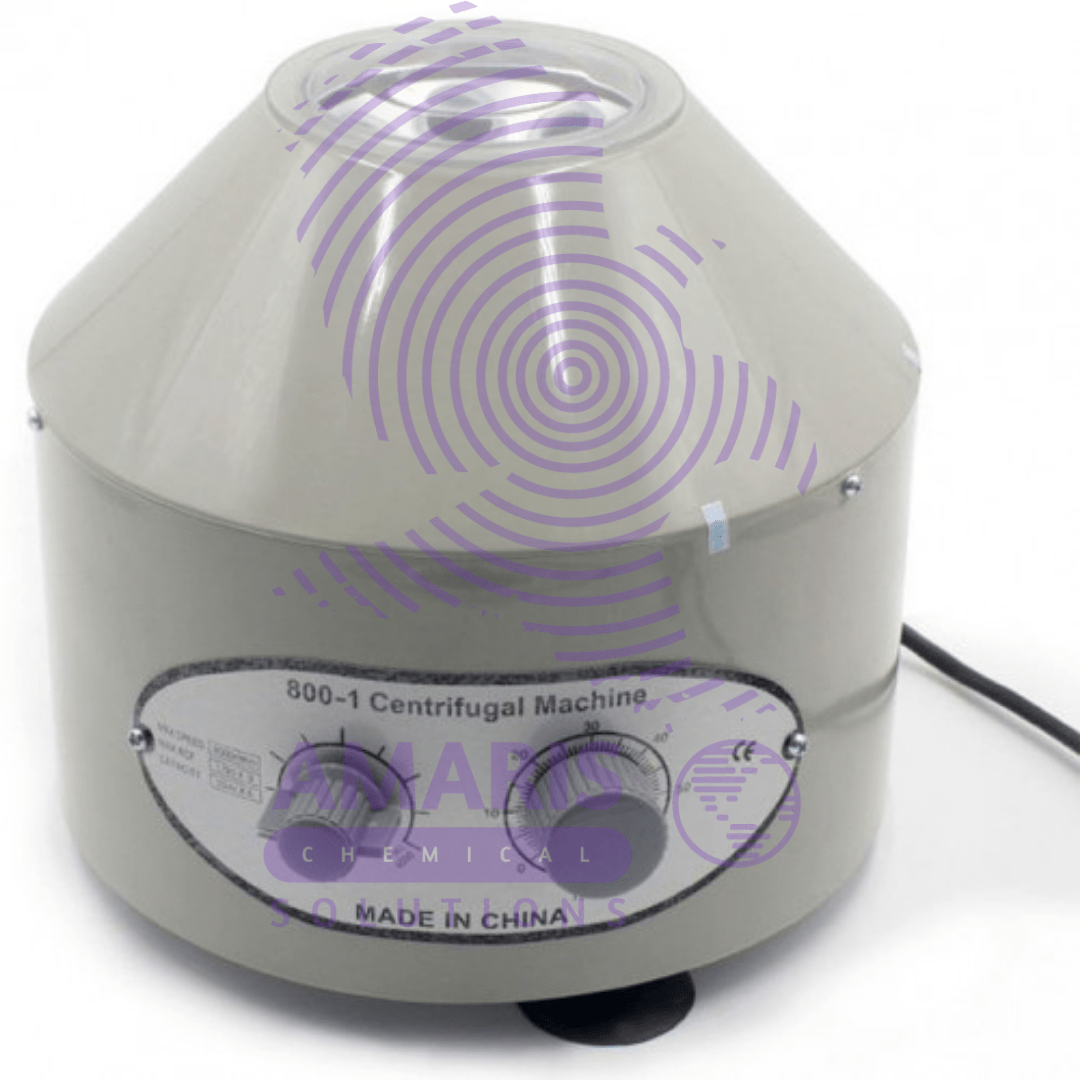

centrifudge electrical
$7,000.00 Original price was: $7,000.00.$6,500.00Current price is: $6,500.00.
centrifuge is a machine that spins samples at high speeds to separate components based on their density. In terms of its electrical components, a centrifuge typically consists of:
- Motor: This is the primary electrical component that drives the rotation of the centrifuge rotor. It converts electrical energy into mechanical energy to spin the rotor.
- Control Panel: Modern centrifuges often have electronic control panels for setting parameters such as speed, duration, and sometimes temperature. These panels may include digital displays, buttons, and knobs for user interaction.
- Safety Features: Centrifuges usually have safety mechanisms, such as lid locks and imbalance detection systems, which are often controlled by electrical circuits. These features help prevent accidents and damage to the centrifuge and its surroundings.
- Power Supply: Like any electrical device, a centrifuge requires a power supply to operate. This could be a standard electrical outlet or a specific voltage and frequency depending on the model.
- Sensors and Feedback Systems: Some centrifuges may incorporate sensors to monitor parameters such as speed, temperature, and rotor balance. These sensors provide feedback to the control system to ensure proper operation and safety.
Uses of centrifudge electrical Centrifuge Electrical
Driving the Rotor:
The primary electrical use of a centrifuge is to power the motor that drives the rotation of the rotor. The rotor holds the samples and spins at high speeds to separate components based on their density.
Control and Monitoring:
Electrical components are used for controlling and monitoring the operation of the centrifuge. This includes setting parameters such as speed, duration, and sometimes temperature through electronic control panels. Sensors may also be employed to monitor factors like speed, temperature, and rotor balance.
Safety Mechanisms:
Electrical systems in centrifuges often include safety mechanisms to prevent accidents and damage. For example, lid locks ensure that the centrifuge cannot be opened while it’s in operation, preventing exposure to potentially hazardous samples. Imbalance detection systems monitor the distribution of mass in the rotor and automatically shut down the centrifuge if imbalance is detected, preventing damage to the machine and ensuring user safety.
Data Recording and Analysis:
Some advanced centrifuges may feature electrical systems for data recording and analysis. This can include logging of operation parameters for quality control purposes or for research and analysis purposes.
Power Supply:
Centrifuges require electrical power to operate. They are typically connected to standard electrical outlets or may require specific voltage and frequency depending on the model.


 Emollients
Emollients Humectants
Humectants UV Filters
UV Filters Surfactants (cosmetic)
Surfactants (cosmetic) Preservatives (cosmetic)
Preservatives (cosmetic) Fragrances and Essential Oils
Fragrances and Essential Oils Antioxidants (cosmetics)
Antioxidants (cosmetics)
 Solvents (lab)
Solvents (lab) Chromatography Chemicals
Chromatography Chemicals Microbiology and Cell Culture Reagents
Microbiology and Cell Culture Reagents Biochemical Reagents
Biochemical Reagents Inorganic and Organic Standards
Inorganic and Organic Standards Spectroscopy Reagents
Spectroscopy Reagents Molecular Biology Reagents
Molecular Biology Reagents
 Precious Metal Extraction Agents
Precious Metal Extraction Agents
 Plasticizers
Plasticizers Polymerization Initiators
Polymerization Initiators Stabilizers
Stabilizers Monomers
Monomers Fillers and Reinforcements
Fillers and Reinforcements Antioxidants (plastics)
Antioxidants (plastics) Colorants (plastic pigments,Dyes)
Colorants (plastic pigments,Dyes)
 Fertilizers
Fertilizers Plant Growth Regulators
Plant Growth Regulators Soil Conditioners
Soil Conditioners Animal Feed Additives
Animal Feed Additives Biostimulants
Biostimulants
 Dough Conditioners
Dough Conditioners Flour Treatments
Flour Treatments Fat Replacers
Fat Replacers Preservatives (baking)
Preservatives (baking)
 Surfactants (cleaning)
Surfactants (cleaning) Builders
Builders Bleaching Agents
Bleaching Agents Enzymes
Enzymes Solvents (cleaning)
Solvents (cleaning) Fragrances
Fragrances Disinfectant
Disinfectant Metal cleaning
Metal cleaning
 Binders/Resins
Binders/Resins Pigments
Pigments Solvents (paint)
Solvents (paint) Additives
Additives Driers
Driers Anti-Corrosion Agents
Anti-Corrosion Agents Specialty Coatings
Specialty Coatings Functional Coatings
Functional Coatings Application-Specific Coatings
Application-Specific Coatings
 Sealants and Adhesives
Sealants and Adhesives
 Biodegradable Surfactants
Biodegradable Surfactants Bio-based Solvents
Bio-based Solvents Renewable Polymers
Renewable Polymers Carbon Capture Chemicals
Carbon Capture Chemicals Wastewater Treatment Chemicals
Wastewater Treatment Chemicals
 Preservatives (food)
Preservatives (food) Flavor Enhancers
Flavor Enhancers Acidulants
Acidulants Sweeteners
Sweeteners Emulsifiers
Emulsifiers Antioxidants (food)
Antioxidants (food) Colorants (food)
Colorants (food) Nutrient Supplements
Nutrient Supplements Nutraceutical Ingredients
Nutraceutical Ingredients
 Fresh Herbs
Fresh Herbs Whole Spices
Whole Spices Ground Spices
Ground Spices Spice Blends
Spice Blends
 Surfactants(oil)
Surfactants(oil)
 Antibiotics
Antibiotics Active Pharmaceutical Ingredients
Active Pharmaceutical Ingredients Excipients
Excipients Vaccine Adjuvants
Vaccine Adjuvants Nutraceutical Ingredients
Nutraceutical Ingredients Solvents (pharmaceutical)
Solvents (pharmaceutical)
 Automotive chemicals
Automotive chemicals Pyrotechnic Chemicals
Pyrotechnic Chemicals


 Vulcanizing Agents
Vulcanizing Agents Accelerators & Retarders
Accelerators & Retarders Antidegradants
Antidegradants Reinforcing Agents
Reinforcing Agents Plasticizers & Softeners
Plasticizers & Softeners Fillers & Extenders
Fillers & Extenders Blowing Agents
Blowing Agents Adhesion Promoters
Adhesion Promoters




















Maragia –
Excellent centrifuge! It’s reliable, quiet, and the digital controls are intuitive. Perfect for our lab’s needs. Very satisfied with this purchase.
Hellen James –
High-quality products
Sheelah Said –
The centrifudge electrical is so fast and it works so well